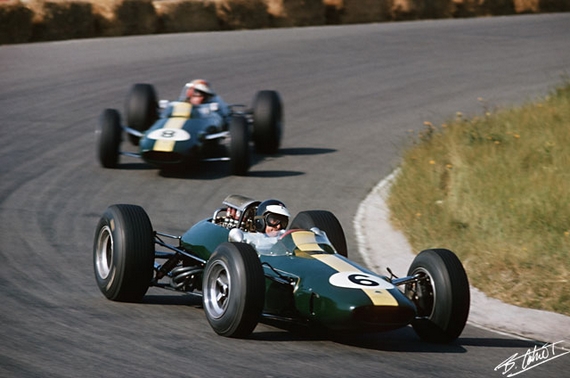
January 2013, the latest chapter in the Lotus F1 book was written with the launch of the E21. And what a long, extraordinary, tangled, successful and intriguing story the marque has produced since its first F1 win 1958.
by Andy Hallbery & Rich Fowler
Chapter 1: New kid and an engine block
By 1963, Lotus was in control, seven wins for Jim Clark, saw Clark take his and the first titles for Team Lotus. The team was led by the renowned innovator Colin Chapman. That ’63 season was dominant, Clark scoring almost twice as many points as his closest chasers, Graham Hill and Richie Ginther, and it just the start of great success to come for the Hethel, Norfolk team. It was the first of six Team Lotus drivers titles between 1963 and1978.
The ground-breaker was the Cosworth DFV engine built with Ford for 1967. It was soon the obvious “must have” engine plant, and clinched the 1968 constructors with the subtle addition of front and rear wings to the Lotus 49, another first in Formula 1. A derivative of the record-setting engine was still winning races in 1983.
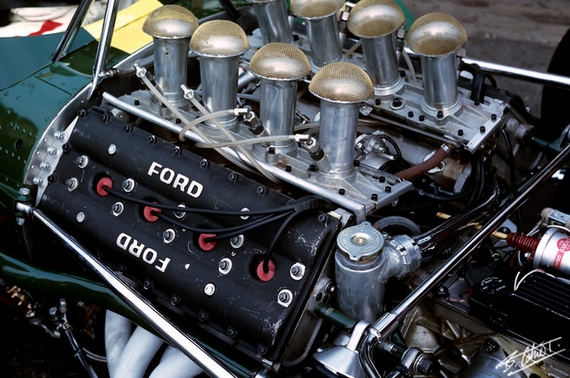
Ford-Cosworth DFV (image- Cahier Archive)
Team Lotus and the Scotsman won again in 1965 and Hill took the crown in 1968 after Clark’s death. Further driver titles for Jochen Rindt (1970),Emerson Fittipaldi (1972), and Mario Andretti (1978) completed ‘Chap-man-ter’ One era in the Team Lotus history book – largely dominated by the Lotus 72 and its offspring;
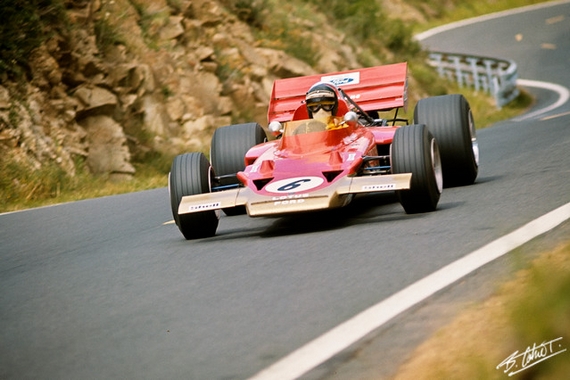
Jochen Rindt (image- Cahier Archive)
Innovations & stars: Ford Cosworth DFV, wings, monocoque, Jim Clark, Graham Hill
Chapter 2: The only way is down(force)
Team Lotus won the 1973 constructors title before a period of relative struggle during the mid 1970s. For 1974, Lotus lost Fittipaldi to McLaren, and the legendary Lotus 72 was out of date, having finished its winning ways. Chapman suddenly had a big hill to climb.
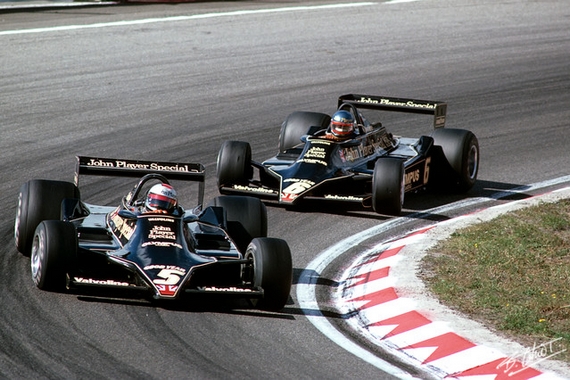
Andretti and Peterson 1978 (image- Cahier Archive)
The 78, and especially the gorgeous 79, exemplified the thoughts and strengths of the DFV and ground effect, culminating in a neat and tidy car which brought the team back to superiority. Innovations came and went, unsuccessfully (twin chassis, all carbon cars etc). Elio de Angelis won in 1982 (the first since Chapman’s death), but that was a champagne blip in a downward trend. Peter Warr took over the team, Gerard Ducarouge the technology.
The next major step for the team was in fact human, in the arrival of Ayrton Senna. The cars were evolutions, not breaking down new doors. Senna won in 1985, and was generally considered fastest, if the car was not, the package still took race wins, and the next ‘tearing up of the tried and trusted’ arrived am before it ith a whole new way of thinking.

Senna kept winning for Lotus (image- Cahier Archive)
Before his death, Chapman had begun work on a revolutionary active suspension system, and it is fair to say it was a disaster, and set the team further back as the car had a handling mind of its own. However it was finally developed into a race winner as Senna won with it on the streets of Monaco and Detroit in 1987. But the good old days had gone……. the end of the ‘86 season when the iconic black & gold John Player livery was replaced by the violent yellow of Camel was a symobolic change. During the period Senna had persuaded Honda to join, so the ingredients were there, but had failed to deliver as a unit. That was the end of Team Lotus being winners.
Innovations & stars: Twin chassis, active suspension, ground effect, Mario Andretti, Honda power, Ayrton Senna
Chapter 3: What’s in a name?

Piquet arrived for 1988 (image- Cahier Archive)
Despite subsequent drivers of the quality such as Nelson Piquet, Mika Hakkinen and Alex Zanardi, the results, disappeared and the Lotus name was a failing brand and quickly becoming a laughing stock. Owners, designers, management came and went, and the halcyon winning days seemed long ago. Honda became Judd, then Lamborghini, Mugen and finally back to Ford. It was a mess. As the results disappeared, so did the funds. Woefully in debt, the team stumbled on until Belgium’s Phillipe Adams took the team to a new low, paying to drive, and failing to qualfy

Hakkinen took two fouth places during his Lotus spell from 1991-1992 (image- Cahier Archive)
In Sept 1994 Team Lotus applied for Administration with debts between $10-16m to avoid creditors. Tom Walkinshaw bought Herbert, placed him at Benetton, then Ligier, then Benetton again. Benetton is a family tree of its own. Team Lotus, meanwhile joined with Pacific, but the flame was now an ember. It was snuffed out completely at the end of 1995.

Zanardi failed to score a point in 1994 (image- Cahier Archive)
Innovations & stars: No innvoations, Hakkinen
Chapter 4: Sliding doors, new beginnings and a return to winning ways

Benetton sponsored the Toleman of Teo Fabi in 1985 (image- Cahier Archive)
Whilst 1994 and 1995 were Team Lotus’s darkest days, the team that would eventually become the Lotus F1 team, Toleman, were hitting their straps, taking back to back drivers titles as Benetton. Toleman joined F1 in 1981, with little success. In 1985 Benetton, an Italian knitwear firm joined the team as the major sponsor. Benetton bought the team outright in 1986 and the teams fortunes improved, culminating in Schumacher winning the championship in 1994 and ’95 amid rumours of rule-bending. By its final race in 2001, Benetton had an impressive record. 27 wins, two drivers world championships and the 1995 constructors title.

Schumacher captured two titles for Benetton in 1994-1995 (image- Cahier Archive)
The team was sold to Renault for $120m in 2000 and rebranded Renault F1 in 2002. The team was back on the rise. Fernando Alonso joined in 2003 and by 2006 became (at the time) the youngest ever double world champion after also taking the title in 2005. At the end of 2009, Renault sold its majority stake, opening the door for the Lotus return.

Alonso went back to back in 2005-2006 (image- Cahier Archive)
The name “Lotus” returned to the F1 grid in 2010, under the Lotus Racing banner. This was the Proton project (Group Lotus) run by Tony Fernandes, and is now called Caterham F1. (Previously Lotus Racing in 2010, Team Lotus in 2011 and Caterham F1 in 2012)
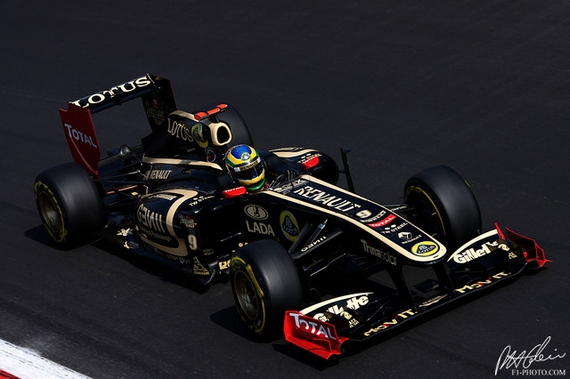
Bruno Senna ran in the iconic black and gold livery for Lotus Renault GP in 2011 (image- Cahier Archive)
In 2011 there were two “Lotus” teams on the grid! Group Lotus, with a new CEO and a change in strategy, joined the Renault F1 Team as a sponsor and the team became “Lotus Renault GP” complete with black and gold iconic livery. Tony Fernandes (Lotus Racing) frustrated by what he saw as a breach of contract from Group Lotus, acquired the “Team Lotus” name from David Hunt,(who had acquired the name when the original Team Lotus went bust in 1995) and the result was mass confusion. The fights over the name are an entire other story, but for 2012 sanity prevailed and there would only be one “Lotus” on the grid.

Heikki Kovalainen ran under the Team Lotus name with green and yellow colous in 2011. It was confusing for fans. (image- Cahier Archive)
Innovations: Traction control? Michael Schumacher, Fernando Alonso, Ross Brawn, and nine other key staff.
Chapter 5 and beyond: The Kimi “leave me alone” era

Raikkonen retuned Lotus to the top step of the podium (image- Cahier Archive)
For 2012 the Lotus F1 team retunrned to the top step of the podium with 2007 World Champion Kimi Raikkonen delivering the team a victory in Abu Dhabi.
This week the team launched its latest challenger the E21 and a new chapter will be written

2013 Lotus F1 Team challenger – The E21
Thanks to Paul-Henri Cahier and his photo archive
Follow @MotosportRetro and @Hallbean on Twitter and join in on the discussion on Facebook
Five Chapters of Lotus History is a post from Motorsport Retro, bringing you classic motorsport, cars, motorcycles and gear every day.